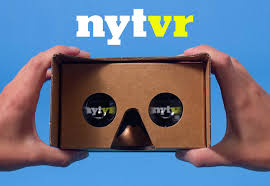New York Times VR: Embed yourself with Iraqi forces during a battle with ISIS

Want to travel all across the world to attend important events? – NYTimes VR promises to fly you.
New York Times is becoming a pioneer in VR content creation. This year, at Cannes Lion, they won the Grand Prix for its VR app.[1] It has produced about 30 VR projects (news stories) so far with its content unit T-brand, and the stories can be viewed using Google Cardboard or Daydream ready headsets.[2]
Historically, news stories have not been very immersive personal experience for customers. They read, and visualize the content themselves, or watch news videos to empathize with the story. To give readers an additional emotional appeal on the stories, NYTimes VR launched 360 degree immersive, video experience with their award winning journalists as anchors. Here is a link to one of their famous news story, ‘displaced’, on war and conflict:
Further, they have a section, ‘NY Times real estate’ where they give customers better understanding and feel for living in a particular home and neighborhood.[3] Also, it creates value for its partners by generating content for their VR devices.
NYTimes, at this point, captures value by acting as consultants for new VR AD makers. Such advertisement videos are then added to app users’s list of videos to watch. For example: IBM ad with flying bees was produced by T – Brand studio, a unit of Times. Further, they have bought FakeLove, an ad firm who pioneers VR ads to complement their effort.[4] Further, most of their news – stories are funded by their sponsors. For example: Hilton, and NYTVR works as distribution channel. [5]
Recommendations:
Coinnovation:
Technology, content, and distribution are co-dependent in the VR newstory cycle. Therefore, NYTimes should continue to partner with device manufacturers, create content, and supplement their partners by being a distributor. That it has a large customer base, it is uniquely positioned to take VR technology to the mainstream market. They have successfully innovated in this front. Their collaboration with Samsung, which supplied NYTimes journalists access to its Gear 360 cameras, and Google, which gave out one million Google Cardboard VR viewers to NYTimes subscribers, benefitted everyone of them: It funded NYTimes news VR stories; created contents for Google and Samsung VR devices.
Increase user base – network effect:
They have to continue to invest/partner with new technologies which would reduce the time/cost of their production. At present, it takes one and half times more than a standard digital video for pre-production, and the shoots cost around twice the normal videos. Further, post-production cost runs ten times more than the usual. [6] This process shouldn’t reduce the content of their videos as that is what readers expect from NyTimes. Also, they have to continue investing on increasing their user subscribers to optimize network effect advantage as that will attract more partners to pour in money to subsidize their content stories.
References:
[1] http://www.fipp.com/news/features/new-york-times-exec-on-vr-and-native-advertising-potential
[2] http://www.nytimes.com/marketing/nytvr/
[3] http://www.nytco.com/the-new-york-times-real-estate-debuts-virtual-reality-tours/
[4] http://www.fipp.com/news/features/lessons-from-the-new-york-times-on-virtual-reality
[5] http://www.fipp.com/news/features/nyt-vr-experimentation-is-making-money
[6] http://adage.com/article/media/mini-ny-times-created-a-watershed-moment-vr/301334/



Very interesting post! Big thumb up for the incredible VR stories that NYT did. As far as I know, many media organizations are trying the VR technology. Once the New York Times loses the first mover advantage, what’s the next? The paper has been losing money, while its digital ad revenue also fell last year. Developing VR is very costly. I’m not sure if it will improve the paper’s financials.
Thanks, Bonnie! It is an important question. I think NYTimes should use its huge subscriber base as a tool and play to its strength. Many content providers and device manufactures look to target varied users and they find media to be one of the areas as well. Co-innovation with these players by totally zeroing their cost to create content is key to their success.